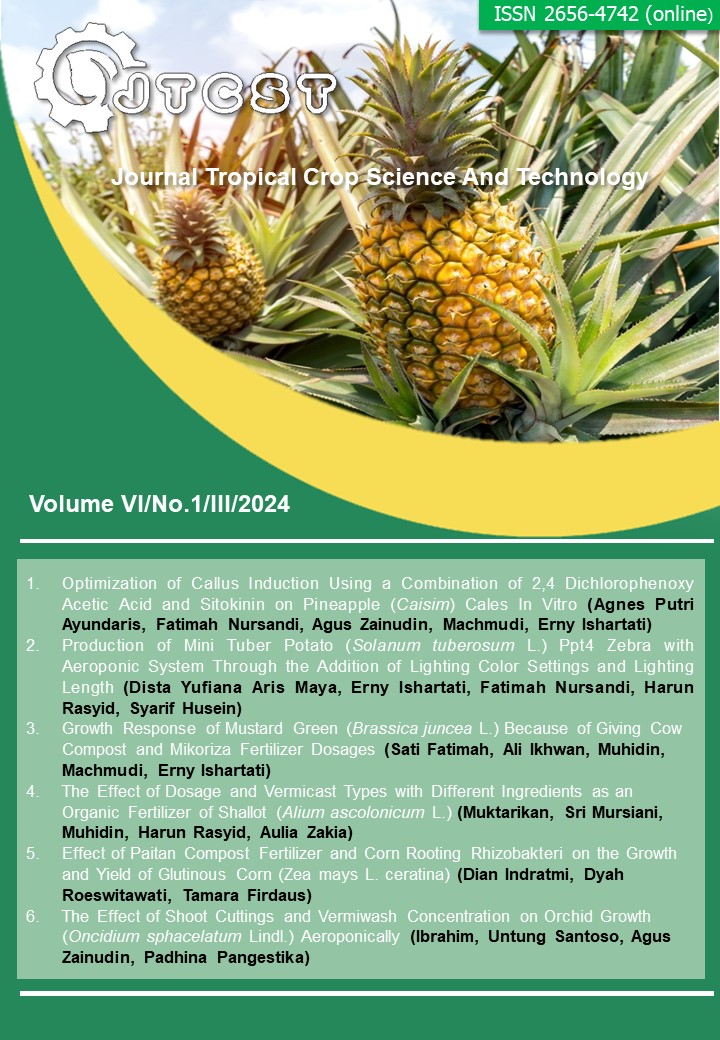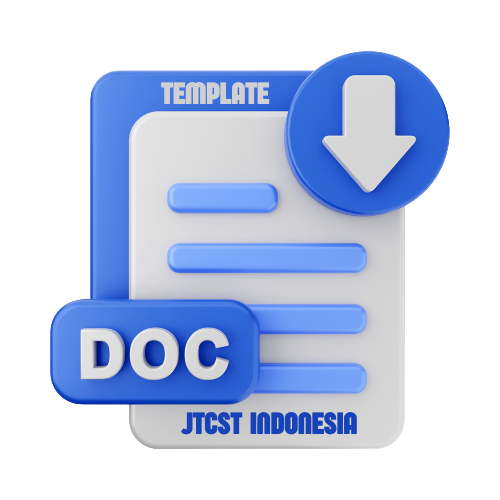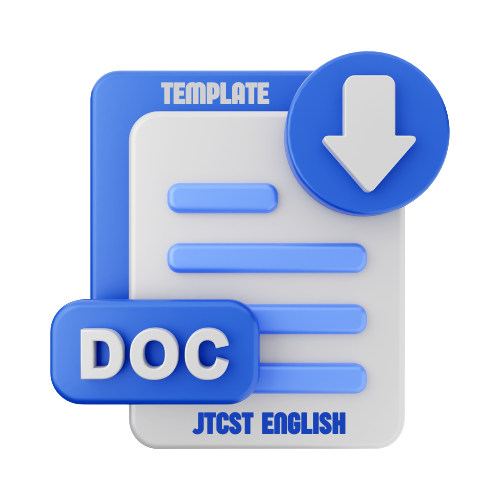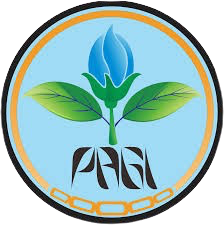The Effect of Shoot Cuttings and Vermiwash Concentration on Orchid Growth (Onchidium sphacelatum Lindl.) Aeroponically
DOI:
https://doi.org/10.22219/jtcst.v6i1.32984Keywords:
orchid, number of shoots, vermiwashAbstract
The Oncidium sphacelatum orchid, commonly propagated vegetatively through pseudobulb separation, presents opportunities for further research into propagation methods and organic fertilizer application. This study, conducted in Batu City, aimed to explore the interaction between vermiwash concentration and shoot number on aeroponically cultivated Orchid sphacelatum Lind cuttings, as well as individual treatment effects.
Employing a factorial RKLT design with shoot number (one or two) and vermiwash concentration (100, 200, or 300 ml/L) as factors, the study evaluated plant height, leaf count, stem length, shoot length, root count, and root length as variables. Data analysis involved ANOVA and BNJ tests. Results revealed that cuttings with two shoots and a 200 ml/L vermiwash concentration promoted optimal leaf growth. The number of shoots influenced shoot length, with two shoots demonstrating superior growth compared to single shoot cuttings. Interestingly, vermiwash concentration did not significantly impact shoot growth parameters, indicating that its effects may be limited in this context. This study sheds light on the potential benefits of using vermiwash in orchid cultivation, particularly in enhancing leaf growth when combined with multiple shoot cuttings. However, further investigation is needed to understand the nuanced effects of vermiwash on other growth aspects and its interaction with different propagation methods.Overall, the findings contribute to the optimization of orchid propagation techniques, providing valuable insights for orchid growers seeking to enhance plant growth and productivity sustainably. Further research could delve deeper into the mechanisms underlying the observed effects and explore additional variables to refine cultivation practices for Oncidium sphacelatum orchids.
Downloads
References
Anisa, N., Reine, S.W., dan Asnawati. 2016. Pengaruh BAP Terhadap Multiplikasi Tunas Anggrek Hitam (Coelogyne pandurata Lindl) secara Kultur Jaringan. Jurnal Hutan Lestari, Vol. 4 (4): 591-595.
Buckerfield J,C., Flavel, T, C., Lee KE, Webster KA, Diazcozin DJ, Jesus JB, Trigo D, Garvin MH. (1999). Vermicompost in solid and liquid forms as a plant growth promoter. 6th international symposium on earthworm ecology, Vigo, Sain, 1998. Pedobiologia 43:753–759.
Chattopadhyay, A. 2015. Effect of vermiwash of Eisenia foetida produced by different methods on seed germination of green mung, Vigna radiata. Int J Recycl Org Waste Agricult 4:233–237.
Costa, M. C. G. 2012. Soil and Crop Responses to Lime and Fertilizers in a Fire Free Land Use System For Smallholdings in the Northern Brazilian Amazon. Soil Till. Res. 121:27-37.
George,S., Giraddi R,S., Patil R,H. (2007). Utility of vermiwash for the management of Thrips and Mites on chili (Capsicum annuum L.) amended with soil organics. Karnataka J Agric Sci 20:657–659.
Hariyanto, S., Pratiwi, I.A., & Utami, E.S.W. 2020. Seed morphometry of native Indonesian orchids in the genus Dendrobium. Hindawi Scientifica, 2020: 1-14.
Hartati, S., Yunus, A., Cahyono, O., dan Setyawan, B. A. 2019. Penerapan Teknik Pemupukan pada Aklimatisasi Anggrek Hasil Persilangan Vanda di Kecamatan Matesih Kabupaten Karanganyar. PRIMA: Journal of Community Empowering and Services. 3 (2), 63-70.
Oktafian, A. R., Septia, E. D., & Nursandi, F. (2023). Potensi Komunitas Bakteri Simbion Cacing Tanah Vermiwash dalam Memproduksi Fitohormon IAA pada Jagung Potential of the Earthworm Vermiwash Symbiont Bacterial Community to Produce IAA Phytohormones in Corn.
Purwanto, A. W. 2016. Anggrek-Budi Daya dan Perbanyakan. LPPM UPN Veteran Yogyakarta Press. Yogyakarta.
Rhs.org.uk, Oncidium Orchid. Growing Guide How To Propagation, https://www.rhs.org.uk/plants/oncidium/warm/growing-guide. 17 Juli 2023.
Santoso, S., Manohara, Y.S.W., and Rochiman, K.S., 2014. Dendrobium spectabile (Blume) Miq. In Vitro Culture And Its Acclimatization on MUS Media With Antimicrobial and Alcoholic Sugar Supplementation. Journal of Biological Researches. Vol. 20 No. 1: 36-41.
Sari, E. R., C. Udayana., dan T. Wardiyati. 2011. Pengaruh Volume Pemberian Air dan Konsentrasi Pupuk Daun terhadap Pertumbuhan Vegetatif Tanaman Anggrek Dendrobium undulatum. Buana Sains 11:77-82.
Shafique, I., Andleeb, S., Aftab, M.S., Naeem, F., Ali, S., Yahya, S., Ahmed, F., Tabasum, T., Sultan, T., Shahid, B., Khan, A.H., 2021. Efficiency of cow dung based vermicompost on seed germination and plant growth parameters of Tagetes erectus (Marigold). Heliyon 7 (1), e05895.
Syahroni, M,I., Istirochah,P., Siti, A,M. 2021. Pengaruh Kombinasi Vermikompos dan Vermiwash Terhadap Pertumbuhan dan Hasil Tanaman Sawi (Brassica rapa L.). Jurnal Agronisma. Vol 10, No 1: 13-24.
Sundararaj, K., Jayasankar, A., 2014. Effect of vermiwash on growth and yield of brinjal, Solanum melongena (eggplant or aubergine). Asian J. Sci. Technol. 5 (3), 171–173.5.
Thangavel P, Balagurunathan R, Divakaran J, Prabhakaran J (2003) Effect of vermiwash and vermicast extraction soil nutrient status, growth and yield of paddy. Adv Plant Sci 16:187–190.
Downloads
Published
How to Cite
Issue
Section
License
Copyright (c) 2024 Ibrahim, Untung Santoso, Agus Zainudin, Padhina Pangestika

This work is licensed under a Creative Commons Attribution-ShareAlike 4.0 International License.
Authors who publish with this journal agree to the following terms:
- Authors retain copyright and grant the journal right of first publication with the work simultaneously licensed under a Creative Commons Attribution License that allows others to share the work with an acknowledgement of the work's authorship and initial publication in this journal.
- Authors are able to enter into separate, additional contractual arrangements for the non-exclusive distribution of the journal's published version of the work (e.g., post it to an institutional repository or publish it in a book), with an acknowledgement of its initial publication in this journal.
- Authors are permitted and encouraged to post their work online (e.g., in institutional repositories or on their website) prior to and during the submission process, as it can lead to productive exchanges, as well as earlier and greater citation of published work (See The Effect of Open Access).











